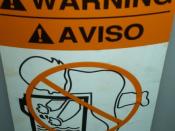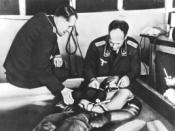ABSTRACTThis paper reviews the contributions of hypothermia and the mammalian diving reflex (MDR) to human survival of cold-water immersion incidents. It also examines the relationship between the victim's age and MDR and considers the protective role played by hypothermia. Hypothermia is the result of a reduced metabolic rate and lowered oxygen consumption by body tissues. Although hypothermia may produce fatal cardiac arrhythmias such as ventricular fibrillation, it is also associated with bradycardia and peripheral vasoconstriction, both of which enhance oxygen supply to the heart and brain. The MDR also causes bradycardia and reduced peripheral blood flow as well as laryngospasm, which protects victims against rapid inhalation of water. Studies of drowning and near drowning of children and adults suggest that victim survival depends on the presence of both hypothermia and the MDR, as neither alone can provide adequate cerebral protection during long periods of hypoxia. Future research is suggested to improve patient care.
INTRODUCTIONDrowning and near-drowning incidents are leading causes of mortality and morbidity in both children and adults . Over the past 30 years, there has been considerable interest in cold-water immersion incidents, particularly the reasons for the survival of some victims under seemingly fatal conditions. Research suggests that both hypothermia and a ÃÂmammalian diving reflexÃÂ (MDR) may account for survival in many near-drowning episodes However, the extent to which these two processes interact is not fully understood. Controversy also exists regarding the effect of the victim's age on the physiological responses to cold-water immersion. In this paper, I provide an overview of recent research on the protective value of hypothermia and the MDR in cold-water immersions. I also examine hypotheses concerning the effects of age on these processes and conclude with suggestions about future lines of research that may lead to improved patient care.
Hypoxia during drowning and near-drowning incidentsThe major physiological problem facing drowning victims is hypoxia, or lack of adequate oxygen perfusion to body cells. Hypoxia results in damage to many organs, including the heart, lungs, kidneys, liver, and intestines. Generally, the length of time the body has been deprived of oxygen is closely related to patient prognosis. Only 6-7 s of hypoxia may cause unconsciousness; if hypoxia lasts longer than 5 min at relatively warm temperatures, death or irreversible brain damage may result. However, some victims of cold-water immersion have survived after periods of oxygen deprivation lasting up to 2 h.
CONCLUSIONSRecent research on cold-water immersion incidents has provided a better understanding of the physiological processes occurring during drowning and near-drowning accidents. Current findings suggest that the cooperative effect of the MDR and hypothermia plays a critical role in patient survival during a cold-water immersion incident . However, the relationship between the two processes is still unclear. Because it is impossible to provide an exact reproduction of a particular drowning incident within the laboratory, research is hampered by the lack of complete details. Consequently, it is difficult to draw comparisons among published case studies.
More complete and accurate documentation of cold-water immersion incidents--including time of submersion; time of recovery; and a profile of the victim including age, sex, and physical condition--will facilitate easier comparison of individual situations and lead to a more complete knowledge of the processes affecting long-term survival rates for drowning victims. Once we have a clearer understanding of the relationship between hypothermia and the MDR--and of the effect of such factors as the age of the victim--physicians and rescue personnel can take steps to improve patient care at the scene and in the hospital.
Cited References1. Kallas HJ, OÃÂRourke PP. Drowning and immersion injuries in children. Curr Opin Pediatr. 1993;5(3):295-302.
2. Keatinge WR. Accidental immersion hypothermia and drowning. Practitioner 1997;219(1310):183-187.
3. Gooden BA. Why some people do not drownÃÂhypothermia versus the diving response. Med J Aust. 1992;157(9):629-632.
4. Biggart MJ, Bohn DJ. Effect of hypothermia and cardiac arrest on outcome of near-drowning accidents in children. J Pediatr. 1999;117(2 Pt 1):179-183.
5. Gooden BA. Drowning and the diving reflex in man. Med J Aust. 1972;2(11):583-587.
6. Bierens JJ, van der Velde EA. Submersion in the Netherlands: prognostic indicators and the results of resuscitation. Ann Emerg Med. 1999;19(12):1390-1395.
7. Ramey CA, Ramey DN, Hayward JS. Dive response of children in relation to cold-water near drowning. J Appl Physiol. 1987;62(2):665-688.




